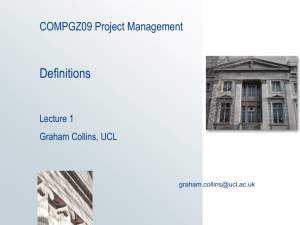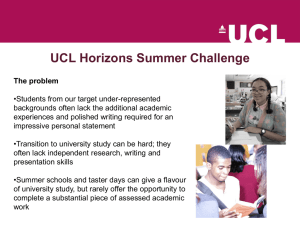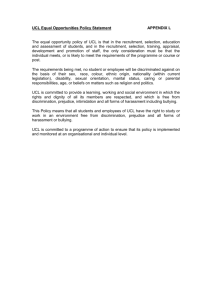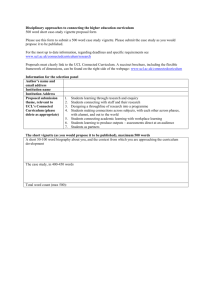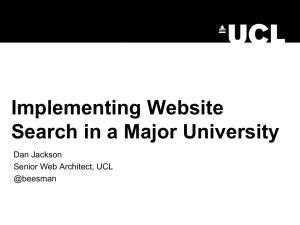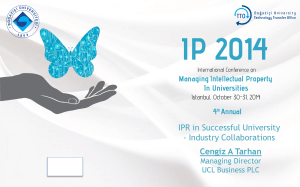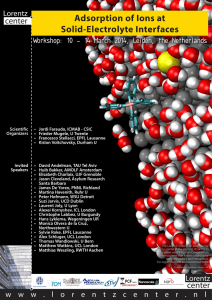Z13: Project Management - UCL Computer Science
advertisement
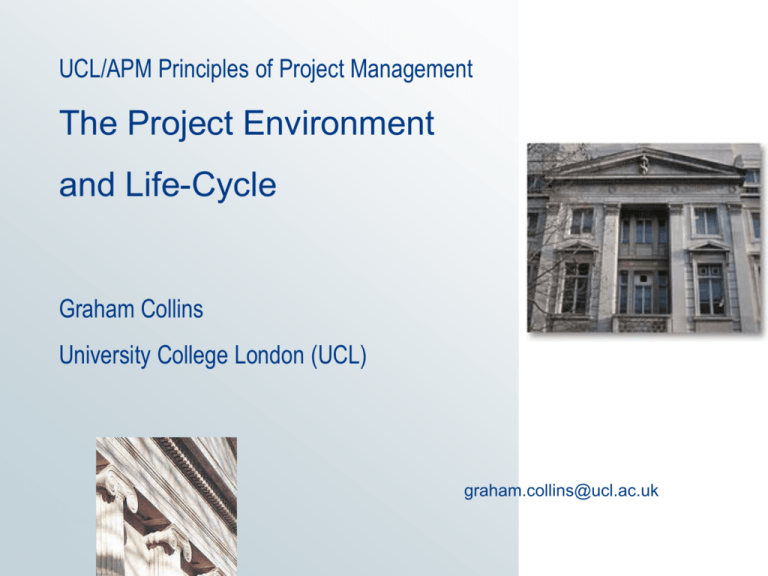
UCL/APM Principles of Project Management The Project Environment and Life-Cycle Graham Collins University College London (UCL) graham.collins@ucl.ac.uk Outline of evening 6.30- 6.50 Welcome/Introduction Student prize award 6.50 -7.20 UCL lecture 7.20- 7.30 Break 7.30- 8.10 Guest Lecture Dr Charles Willbe Questions 8.10- 8.20 Outline of sessions The Project Environment and Life-Cycle Why projects fail Risk Management Work Content and Scope Management Business Case Scheduling (including exercise) Change Control and Earned Value Communications (including the Project Management Plan) Motivation and Team Building Project Evaluation Goals One never goes as far when one doesn’t know where one is going Goethe Operations and projects – some examples Operations Projects Order processing and Develop new products – Invoicing – Ford/Mazda Apple iPod Shuffle Manufacture products – Toyota- efficient production operations, Just in Time (JIT) Advertising campaigns – Saatchi and Saatchi – Sagatiba (a drink) Stock management – Supermarket retail, example Sainsbury’s (operation criticised by Computing) Médecins Sans Frontières – medical aid – Tsunami Operations and Projects Operations Projects Task Familiar Unfamiliar Staff Designated Diverse Roles Established Uncertain Culture Role Task Working relationships Established Negotiable Authority Clear Ambiguous Co-ordination Hierarchical Network/Matrix Information sources Routine Uncertain Learning Desirable Essential Momentum Maintained by system Threatened by system Time Horizon Long term Finite Definition of a project ‘A unique set of co-ordinated activities, with definitive starting and finishing points, undertaken by an individual or organisation to meet specific objectives within defined schedule, cost and product performance parameters, BS 6079 – Guide to Project Management Introduce beneficial change Project management is regarded as the most efficient way to introduce beneficial change Defining what has to be accomplished, generally in terms of time cost and various technical and quality parameters. Developing a plan and working through this ensuring progress is maintained. Using appropriate project management techniques and tools to plan, monitor and maintain progress. Employing skilled project management staff, including a project manager who are given responsibility for introducing the change and are accountable for the successful implementation. Based on Project Management pathways edited by Stevens, M. APM, 2002 Change Management - creating the right conditions for project management Change Step Purpose / Outcome Diagnose What is the problem or opportunity? Align Ensure stakeholders understand the necessity Prepare Design a workable approach Commit Seek active stakeholder involvement and secure a champion Mobilise Early wins to gain commitment and confidence Enable Commission enabling changes that lay the foundation for major changes later Action Implement the change and ensure benefits Measure Ensure measurement and review processes are in place Institutionalise Ensure sustainability and improvement Roles and Responsibilities - Project Sponsor Appoint project manager Ensuring the project is and continues to be a viable proposition and is aligned to corporate objectives Signing off / accepting the outputs of the project Resolving issues outside the mandate of the project manager Chairing the Project Board or Steering Committee. Roles and Responsibilities – Project Manager Benefit focused Build in quality Manage risks and issues Exploiting enablers and removing blockers Exploiting resources available Key responsibilities: Provide single point of responsibility Define and plan the project Create the temporary organisation (lead the project team) Manage stakeholders Monitor and control all aspects including risk, opportunities, issues, scope change, benefits etc. Ensure project objectives are delivered on time, to specified cost and quality Manage the hand-over and close down the project. Challenges Securing resources Insufficient authority Conflict of organisational priorities Cannot rely on communication flows Cannot rely on people knowing what is required. Fundamental steps in Project Management Define the project Design the project Develop / build the solution Test the solution Implement the solution Review the project Close the project. Project Support Office Maintain documentation Facilitate the control process Update information / communication systems Issue progress reports Configuration control May undertake procurement Project Life-Cycle Life Cycle phases, from APM Project Management Book of Knowledge Opportunity Identification Concept/ Marketing Design & Development Design, Modelling and Procurement Implement Make, Build and Test Handover Test, Commission, Start-up Operation Operation and Maintenance / Integrated Logistics Phases can be planned and controlled as smaller projects Phases have - inputs, processes and outputs - key activities and milestones Usually need to sign-off to move from one phase to the next Some projects use concurrent processes, where phases overlap. Project Management – Definition ‘Planning, monitoring and control of all aspects of a project and the motivation of all those involved in it to achieve the project objectives on time and to the specified cost, quality and performance.’ British Standard 6079 -1: 2000 Programme Management - Definition ‘Programme Management is the co-ordinated management of a portfolio of projects that change organisations to achieve benefits that are of strategic importance’ Managing Successful Programmes, OGC, The Stationary Office 1999 Programme Management - Benefits Reduction of risk, efficient use and coordination of resources Prioritisation to achieve corporate goals. The Project Environment -the context within the project exists Political Environmental Distributors Contractors Clients The The project project Legal End users PESTLE Economic Organisation Suppliers Technological Social-cultural Kind permission from Jane Walker UCL. This slide and the next 4 are from UCL MAST project management courses 2004 Stakeholders Press/Media Shareholders Government Professional bodies Senior management Regulators Internal users Staff Clients End-users Unions Contractors Project Manager Managers controlling internal resources Distributors Colleagues Suppliers Pressure groups Stakeholder Analysis Who are they Their objectives Past reactions Positive / negative impact of project Possible future reaction Power / interest in the project Actions to gain / maintain support Stakeholder mapping High Level of power & influence .X .Y .Z Low Low Blocker Level of support Undecided High Champion Stakeholder management Projects exist in the wider context Critical influences may vary by type of project Recognise that groups can influence the project Plan and manage their support: - understand their needs - communicate, negotiate, persuade. Book Slot The Definitive Guide to Project Management Sebastian Noakes et al FT Prentice Hall 2003
